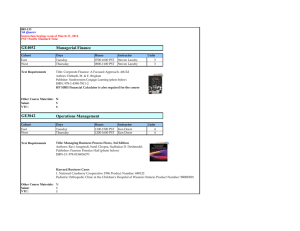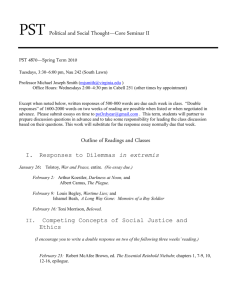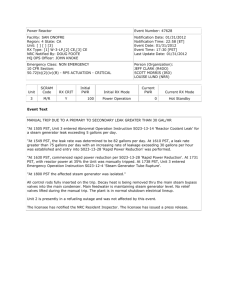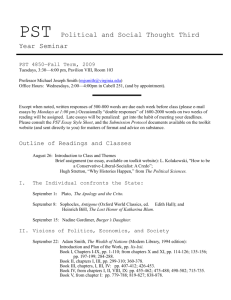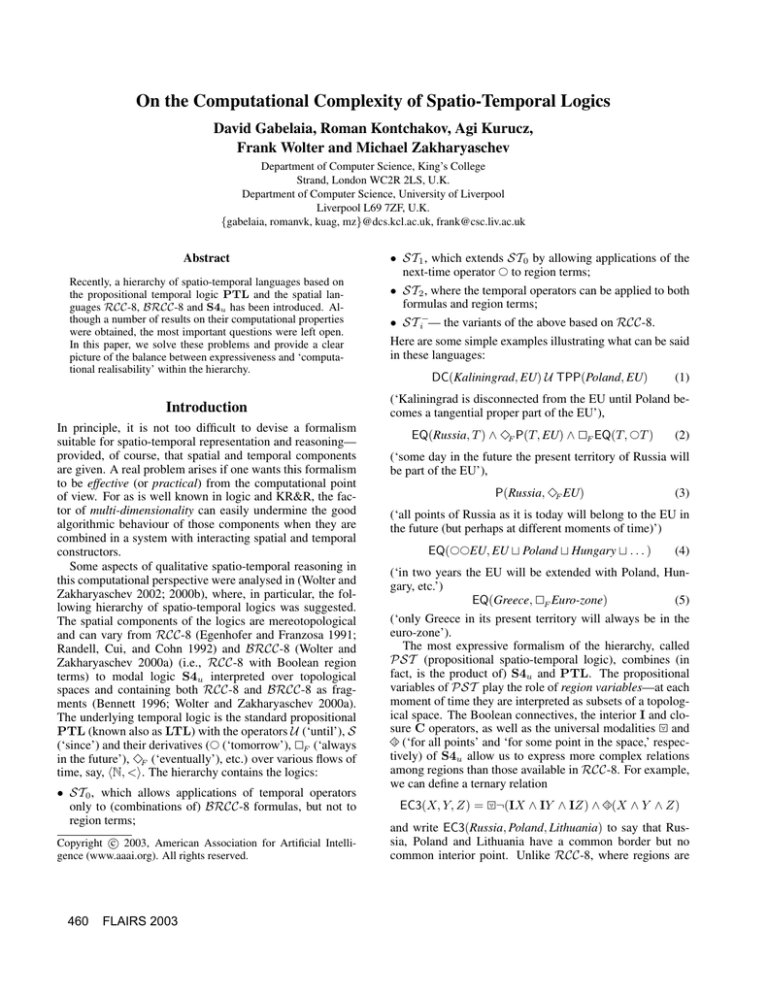
On the Computational Complexity of Spatio-Temporal Logics
David Gabelaia, Roman Kontchakov, Agi Kurucz,
Frank Wolter and Michael Zakharyaschev
Department of Computer Science, King’s College
Strand, London WC2R 2LS, U.K.
Department of Computer Science, University of Liverpool
Liverpool L69 7ZF, U.K.
{gabelaia, romanvk, kuag, mz}@dcs.kcl.ac.uk, frank@csc.liv.ac.uk
Abstract
Recently, a hierarchy of spatio-temporal languages based on
the propositional temporal logic PTL and the spatial languages RCC-8, BRCC-8 and S4u has been introduced. Although a number of results on their computational properties
were obtained, the most important questions were left open.
In this paper, we solve these problems and provide a clear
picture of the balance between expressiveness and ‘computational realisability’ within the hierarchy.
Introduction
In principle, it is not too difficult to devise a formalism
suitable for spatio-temporal representation and reasoning—
provided, of course, that spatial and temporal components
are given. A real problem arises if one wants this formalism
to be effective (or practical) from the computational point
of view. For as is well known in logic and KR&R, the factor of multi-dimensionality can easily undermine the good
algorithmic behaviour of those components when they are
combined in a system with interacting spatial and temporal
constructors.
Some aspects of qualitative spatio-temporal reasoning in
this computational perspective were analysed in (Wolter and
Zakharyaschev 2002; 2000b), where, in particular, the following hierarchy of spatio-temporal logics was suggested.
The spatial components of the logics are mereotopological
and can vary from RCC-8 (Egenhofer and Franzosa 1991;
Randell, Cui, and Cohn 1992) and BRCC-8 (Wolter and
Zakharyaschev 2000a) (i.e., RCC-8 with Boolean region
terms) to modal logic S4u interpreted over topological
spaces and containing both RCC-8 and BRCC-8 as fragments (Bennett 1996; Wolter and Zakharyaschev 2000a).
The underlying temporal logic is the standard propositional
PTL (known also as LTL) with the operators U (‘until’), S
(‘since’) and their derivatives ( (‘tomorrow’), 2F (‘always
in the future’), 3F (‘eventually’), etc.) over various flows of
time, say, N, <. The hierarchy contains the logics:
• ST 0 , which allows applications of temporal operators
only to (combinations of) BRCC-8 formulas, but not to
region terms;
c 2003, American Association for Artificial IntelliCopyright gence (www.aaai.org). All rights reserved.
460
FLAIRS 2003
• ST 1 , which extends ST 0 by allowing applications of the
next-time operator to region terms;
• ST 2 , where the temporal operators can be applied to both
formulas and region terms;
• ST i−— the variants of the above based on RCC-8.
Here are some simple examples illustrating what can be said
in these languages:
DC(Kaliningrad, EU) U TPP(Poland, EU)
(1)
(‘Kaliningrad is disconnected from the EU until Poland becomes a tangential proper part of the EU’),
EQ(Russia, T ) ∧ 3F P(T, EU) ∧ 2F EQ(T, T )
(2)
(‘some day in the future the present territory of Russia will
be part of the EU’),
P(Russia, 3F EU)
(3)
(‘all points of Russia as it is today will belong to the EU in
the future (but perhaps at different moments of time)’)
EQ(EU, EU Poland Hungary . . . )
(4)
(‘in two years the EU will be extended with Poland, Hungary, etc.’)
EQ(Greece, 2F Euro-zone)
(5)
(‘only Greece in its present territory will always be in the
euro-zone’).
The most expressive formalism of the hierarchy, called
PST (propositional spatio-temporal logic), combines (in
fact, is the product of) S4u and PTL. The propositional
variables of PST play the role of region variables—at each
moment of time they are interpreted as subsets of a topological space. The Boolean connectives, the interior I and clo∀ and
sure C operators, as well as the universal modalities 2
∃ (‘for all points’ and ‘for some point in the space,’ respec3
tively) of S4u allow us to express more complex relations
among regions than those available in RCC-8. For example,
we can define a ternary relation
∀ ¬(IX ∧ IY ∧ IZ) ∧ 3
∃ (X ∧ Y ∧ Z)
EC3(X, Y, Z) = 2
and write EC3(Russia, Poland, Lithuania) to say that Russia, Poland and Lithuania have a common border but no
common interior point. Unlike RCC-8, where regions are
usually assumed to be regular closed (i.e, satisfying the con∀ (X ↔ CIX)), S4
dition 2
u allows for more flexibility. In
the extreme, we can express such ‘pathological’ properties
of sets as ‘X is dense in Y , but has no interior:’
∀ ¬IX ∧ 2
∀ (CX ↔ Y ).
2
Consider, for instance, the following PST -formulas
∀ (¬Icockroach ∧ (Ccockroach ↔ habitat)),
2F 2
∀ (habitat → habitat),
2F 2
∀
2C3F cockroach,
saying that (a) the cockroaches form a dense set in their habitat (but for humans they are invisible), (b) the cockroach
habitat will never contract, and (c) sooner or later, cockroaches will appear in the neighbourhood of every place on
Earth.
The results obtained in (Wolter and Zakharyaschev
2000b; 2002) show that the satisfiability problem for the
languages ST i in topological temporal models over various
flows of time is decidable (for ST 2 under the so called finite
state assumption FSA, see below). Moreover, if we consider the flow of time N, <, then ST 2 (under FSA) and
ST 1 are decidable in EXPSPACE, while ST 0 is PSPACEcomplete. The problem of finding the lower bounds for the
ST i , the complexity of ST 1−, as well as the decision problem
for PST have remained open.
The main aim of this paper is to provide solutions to these
problems. The obtained results are summarised in Table 1.
logic
FSA
no FSA
PST
ST 2
ST 2−
ST 1
ST 1−
ST 0
undecidable
EXPSPACE-complete
in EXPSPACE
EXPSPACE-complete
PSPACE-complete
PSPACE-complete
undecidable
?
?
EXPSPACE-complete
PSPACE-complete
PSPACE-complete
Table 1: Complexity of spatio-temporal logics over N, <.
To investigate the computational behaviour of the ST i ,
we (polynomially) embed these logics into the one-variable
fragment of quantified temporal logic QT L based on the
appropriate flow of time. Recent results of (Hodkinson,
Wolter, and Zakharyaschev 2000) on the decidability of
monodic fragments of first-order temporal logic show immediately that all the ST i are decidable and provide upper
bounds for their computational complexity over the flow of
time N, <. To establish the matching lower bounds for
ST 2 (under FSA) and ST 1 , we identify the fragment of
QT L, which can be polynomially embedded into ST 1 , and
show its EXPSPACE-hardness. It then comes as a surprise
that ST 1−turns out to be PSPACE-complete, i.e., as complex
as pure PTL. Another surprising result is the undecidability
of full PST , which is established by a reduction of Post’s
correspondence problem.
It is worth noting that the embedding of the ST i into the
one-variable fragment of QT L makes it possible to use the
tableau- and resolution-based reasoning procedures recently
developed in (Kontchakov et al. 2002; Degtyarev and Fisher
2001).
A full paper containing all proofs will be available on the
web.
Propositional Spatio-Temporal Logic PST
The language PST , or propositional spatio-temporal language, is based on the following alphabet
• propositional (or rather spatial) variables p0 , p1 , . . . ,
• the Booleans (say, ¬ and ∧),
• the binary temporal operators U (until) and S (since),
• the interior I and closure C operators, and
∀ and 3
∃.
• the ‘universal modalities’ 2
We will freely use other Booleans definable via ¬ and ∧, as
well as the temporal operators (‘next-time’), 3F (‘sometime in the future’) and 2F (‘always in the future’) definable
via U
ψ
= ⊥ U ψ,
3F ψ = U ψ,
2F ψ = ¬3F ¬ψ.
The intended models of PST , called topological PST models, are triples of the form M = F, T, U, where
F = W, < is a strict linear order representing the flow
of time, T = U, I a topological space,1 and U, a valuation, is a map associating with every variable pi and every
w ∈ W a set U(pi , w) ⊆ U —the ‘region’ occupied by pi at
moment w. The valuation U is inductively extended to arbitrary PST -formulas in the following way, where by (u, v)
we denote the open interval {w ∈ W | u < w < v}:
• U(¬ψ, w) = U − U(ψ, w);
• U(ψ1 ∧ ψ2 , w) = U(ψ1 , w) ∩ U(ψ2 , w);
• U(Iψ, w) = IU(ψ, w);
U, if U(ψ, w) = U,
∀ ψ, w) =
• U(2
∅, otherwise;
• U(ψ1 U ψ2 , w) = {x ∈ U | ∃v > w (x ∈ U(ψ2 , v) ∧
∀u (u ∈ (w, v) → x ∈ U(ψ1 , u)))};
• U(ψ1 S ψ2 , w) = {x ∈ U | ∃v < w (x ∈ U(ψ2 , v) ∧
∀u (u ∈ (v, w) → x ∈ U(ψ1 , u)))}.
In particular,
U(3F ψ, w) =
U(ψ, v), U(2F ψ, w) =
U(ψ, v),
v>w
v>w
and if F is discrete then
U(ψ, w) = U(ψ, w + 1),
where w + 1 is the immediate successor of w in F.
A PST -formula ϕ is satisfied in M if U(ϕ, w) = ∅ for
some w ∈ W .
1
Here U is a non-empty set, the universe of the space, and I
is the interior operator on U satisfying the standard Kuratowski
axioms: for all X, Y ⊆ U , I(X ∩ Y ) = IX ∩ IY , IX ⊆ IIX,
IX ⊆ X, IU = U . The operator dual to I is called the closure
operator and denoted by C. Thus CX = U − I(U − X).
FLAIRS 2003
461
Recall now (cf. e.g., (Chagrov and Zakharyaschev 1997))
that every Kripke frame G = U, R for Lewis’s modal logic
S4u (R is a transitive and reflexive binary relation on U )
gives rise to the topological space TG = U, IG , where for
every V ⊆ U ,
IG V = {v ∈ V | ∀u ∈ U (vRu → u ∈ V )}.
(The main difference between arbitrary topological spaces
and those generated by quasi-orders and known as Aleksandrov spaces is that all intersections of open sets are open in
the latter, but this is not the case in the former.) This observation motivates the following definition.
A Kripke PST -model is a topological PST -model in
which the topological space is of the form U, IG for some
transitive and reflexive Kripke frame G.
Note that the set of PST -formulas satisfiable in Kripke
models is a proper subset of those satisfiable in topological models. Consider, e.g., the formula 2F Ip ↔ I2F p. It is
clearly true in every Kripke PST -model. On the other hand,
we can satisfy the negation of this formula in a topological
PST -model: it suffices to take the flow of time F = N, <
and the topology T = R, I with the standard interior operator I on the real line, select a sequence Xn of open sets such
that n∈N Xn is not open, for example Xn = (−1/n, 1/n),
and put U(p, n) = Xn .
A fundamental result of (Wolter and Zakharyaschev
2000b; 2002) is that, nevertheless, under certain natural semantical and syntactical conditions it is sufficient to work
with Kripke PST -models. First, this is the case for PST models satisfying the finite state assumption (FSA) which
is formulated as follows. Say that a topological PST model F, T, U (or a Kripke PST -model F, G, U) satisfies FSA if for every variable p there exist finitely many sets
A1 , . . . , Ak such that
{U(p, w) | w ∈ W } = {A1 , . . . , Ak }.
Second, this also is the case for so-called u-formulas. A
∀ ψ or 3
∃ ψ, where ψ is built from
PST -formula of the from 2
propositional variables using the Booleans, the temporal operator and the S4-operators C and I, is called a basic u-formula. A u-formula is a PST -formula constructed
from basic u-formulas using arbitrary connectives of PST .
(Clearly, 2F Ip ↔ I2F p above is not a u-formula.)
Lemma 1. [W&Z 2000b] (i) If a PST -formula ϕ is satisfied in a topological PST -model satisfying FSA and based
on a flow of time F, then ϕ is satisfied in a Kripke PST model satisfying FSA and based on F.
(ii) If a u-formula ϕ is satisfied in a topological PST model based on a flow of time F, then ϕ is satisfied in a
Kripke PST -model based on F as well.
Lemma 1 serves as a basis for both ‘positive’ and ‘negative’ complexity results below. The reason is that relational
structures are much easier to manipulate with than topological spaces. First, we use the lemma to show that the full
language PST is ‘too expressive,’ at least when interpreted
in models over discrete flows of time.
Theorem 2. Let C be one of the following classes of flows
of time: {N, <}, {Z, <}, or the class of all finite strict
462
FLAIRS 2003
linear orders. Then the satisfiability problem for PST formulas in Kripke (and topological) PST -models (with or
without FSA) over the flows of time in C is undecidable.
The proof is by reduction of the undecidable Post’s correspondence problem (PCP) (Post 1946). The encoding of
the problem relies heavily upon the fact that words over a
given alphabet can be regarded as ascending chains of points
in a Kripke model, where the propositional variables are regarded as members of the alphabet, and the fact that the flow
of time is discrete. Theorem 2 holds even for the fragment
∀.
of PST with the sole temporal operator 2F and without 2
Spatio-Temporal Logics Based on BRCC-8
We remind the reader that the language of RCC-8 consists
of a countably infinite set of region variables X0 , X1 , . . . ,
the eight binary predicate symbols DC, EQ, PO, EC, TPP,
NTTP, TPPi, NTTPi and the Booleans out of which we
construct spatial formulas. Spatial formulas are interpreted
in topological spaces, with the region variables ranging over
regular closed sets of T and the intended meaning of the
eight predicates being ‘disconnected,’ ‘equal,’ ‘partial overlap,’ ‘externally connected,’ ‘tangential proper part,’ ‘nontangential proper part’ and the inverses of the last two, respectively.
Given a topological space T = U, I and an assignment a
associating with every region variable Xi a regular closed set
a(Xi ) ⊆ U , the truth-relation T |=a ϕ for atomic formulas
of RCC-8 is defined in the natural way:
T |=a DC(X1 , X2 ) iff ¬∃x x ∈ a(X1 ) ∩ a(X2 );
T |=a EQ(X1 , X2 ) iff ∀x (x ∈ a(X1 ) ↔ x ∈ a(X2 ));
T |=a PO(X1 , X2 ) iff ∃x, y, z x ∈ Ia(X1 ) ∩ Ia(X2 ),
y ∈ a(X1 )∩(U −a(X2 )) and z ∈ (U −a(X1 ))∩a(X2 );
T |=a EC(X1 , X2 ) iff ∃x x ∈ a(X1 ) ∩ a(X2 ) and
¬∃x x ∈ Ia(X1 ) ∩ Ia(X2 );
T |=a TPP(X1 , X2 ) iff ∀x x ∈ (U − a(X1 )) ∪ a(X2 ) and
∃y, z y ∈ a(X1 ) ∩ (U − Ia(X2 )), z ∈ (U − a(X1 )) ∩ a(X2 );
T |=a NTPP(X1 , X2 ) iff ∀x x ∈ (U − a(X1 )) ∪ Ia(X2 ) and
∃x x ∈ (U − a(X1 )) ∩ a(X2 ).
An RCC-8-formula is said to be satisfiable in a topological space T if there is an assignment a in T such that
T |=a ϕ.
Remark 3. It is often required that region variables are only
interpreted by non-empty regular closed sets. We do not impose this restriction for two reasons. First, we can always
express that region X is non-empty by constraints EC(X, Y )
or TPP(X, Y ), etc., for some dummy variable Y . And second we will need empty regions to interpret complex region
terms of BRCC-8 below.
The satisfiability problem for RCC-8 formulas in topological spaces is NP-complete (Renz and Nebel 1999), while
that for S4u formulas is PSPACE-complete. So by replacing S4u with RCC-8 we may hope to get a spatio-temporal
formalism with better computational properties.
One apparent ‘deficit’ of RCC-8 is that it operates only
with atomic regions. Denote by BRCC-8 the extension of
RCC-8 which allows for Boolean region terms, i.e., combinations of region variables using the Booleans , and
¬, as arguments of RCC-8 predicates. The value a(t) of a
Boolean region term t in a topological space T = U, I under an assignment a is defined inductively as follows:
a(¬t) = CI(U − a(t)),
a(t1 t2 ) = CI(a(t1 ) ∪ a(t2 )),
a(t1 t2 ) = CI(a(t1 ) ∩ a(t2 )).
As the Boolean operators do not in general preserve the
property of being regular closed, we need the prefix CI in
the right-hand parts of these definitions.
The computational behaviour of BRCC-8 in arbitrary
topological spaces is precisely the same as that of RCC-8
(Wolter and Zakharyaschev 2000a).
There are different ways of introducing a temporal dimension into the syntax of BRCC-8, which give rise to a hierarchy of possible spatio-temporal logics.
ST 0 . The most obvious one allows applications of the temporal operators U and S only to spatial BRCC-8 formulas. More precisely, every formula of BRCC-8 is an ST 0 formula, and if ψ1 and ψ2 are ST 0 -formulas, then so are
¬ψ1 , ψ1 ∧ψ2 , ψ1 U ψ2 and ψ1 S ψ2 . However, the expressive
power of ST 0 is rather limited. In particular, we can compare regions only at one moment of time, but are not able to
connect a region as it is ‘today’ with its state ‘tomorrow’ to
say, e.g., that it is expanding or remains the same.
ST 1 . To capture this dynamics, we extend ST 0 by allowing
applications of the next-time operator not only to formulas but also to Boolean region terms. Thus, arguments of the
predicate symbols of RCC-8 can be now arbitrary region terms which are constructed from region variables using the
Booleans and . For instance, X represents region X as
it will be ‘the day after tomorrow.’ Denote the resulting language by ST 1 . Obviously, ST 1 is more expressive than ST 0
only for discrete flows of time; in dense flows of time like
Q, < or R, < the ‘next-time’ operator makes no sense.
ST 2 . We can also extend ST 0 by allowing the use of temporal region terms, constructed from region variables, the
Booleans and the temporal operators U and S as arguments
of the RCC-8 predicates. In other words, every region variable is a temporal region term, and if t1 and t2 are temporal
region terms then so are ¬t1 , t1 t2 , t1 t2 , t1 U t2 , t1 S t2 .
The resulting language is denoted by ST 2 .
ST i−. The languages ST i−, i = 0, 1, 2, do not allow the use
of the Booleans for constructing region terms—we can use
only region variables and the permitted temporal operators.
The spatio-temporal languages ST 0 , ST 1 and ST 2 are interpreted in topological temporal models (or tt-models, for
short) M = F, T, a which differ from topological PST models only in that a assigns to every region variable Xi and
every moment of time w in F a regular closed set a(X, w)
in T, the state of X at w. The assignment a is extended to
temporal region terms as follows:
a(¬t, w) = CI(U − a(t, w)),
a(t1 t2 , w) = CI(a(t1 , w) ∪ a(t2 , w)),
a(t1 t2 , w) = CI(a(t1 , w) ∩ a(t2 , w)),
a(t1 U t2 , w) = CI{x | ∃v > w (x ∈ a(t2 , v)∧
∀u (u ∈ (w, v) → x ∈ a(t1 , u)))},
a(t1 S t2 , w) = CI{x | ∃v < w (x ∈ a(t2 , v)∧
∀u (u ∈ (v, w) → x ∈ a(t1 , u)))}.
In particular, a(t, w) = a(t, w + 1) and
a(2F t, w) = CI
a(t, v), a(3F t, w) = CI
a(t, v).
v>w
v>w
For a tt-model M = F, T, a, an ST i -formula ϕ and a w
in W , we define the truth-relation (M, w) |= ϕ (‘ϕ holds in
M at moment w’) by induction on the construction of ϕ:
• (M, w) |= R(t1 , t2 ) iff T |=b R(X1 , X2 ), where R is
one of the RCC-8-relations, t1 and t2 are temporal region
terms, and b(Xj ) = a(tj , w), for j = 1, 2;
• (M, w) |= ¬ψ iff (M, w) |= ψ;
• (M, w) |= ψ1 ∧ ψ2 iff (M, w) |= ψ1 and (M, w) |= ψ2 ;
• (M, w) |= ψ1 U ψ2 iff there exists v > w such that
(M, v) |= ψ2 and (M, u) |= ψ1 for every u ∈ (w, v),
• (M, w) |= ψ1 S ψ2 iff there exists v < w such that
(M, v) |= ψ2 and (M, u) |= ψ1 for every u ∈ (v, w).
As before, we say that a tt-model M = F, T, a satisfies
FSA if for every region variable X there are only finitely
many regular closed sets A1 , . . . , Ak ⊆ U such that
{a(X, w) | w ∈ W } = {A1 , . . . , Ak }.
As was shown in (Wolter and Zakharyaschev 2000b;
2002), the languages ST i can be embedded in PST . More
precisely, one can construct a polynomial translation ·†
which associates with every ST i -formula ϕ a PST -formula
ϕ† in such a way that, for any tt-model M = F, T, a, if
we take the PST -model M = F, T, U, where U(pi , w) =
a(Xi , w), then
(M, w) |= ϕ
iff
U(ϕ, w) = ∅.
The languages ST i are computationally simpler than
PST , because the modal translations of ST 2 -formulas form
a rather special fragment of the modal language PST . Renz
(1998) showed that an RCC-8-formula ϕ is satisfiable iff
its translation ϕ† is satisfiable in a Kripke model based on
saws—disjoint unions of forks—with a fork being a threepoint frame {b, r, l}, R such that bRr and bRl. Actually,
it turns out that this result can be generalised to ST 2 - and
ST 1 -formulas (in the former case we assume FSA).
Theorem 4. [W&Z 2000b] (i) An ST 2 -formula ϕ is satisfied
in a tt-model with FSA and based on a flow of time F iff ϕ† is
satisfied in a Kripke PST -model F, G, U with FSA whose
underlying S4-frame G is a saw.
(ii) An ST 1 -formula ϕ is satisfied in a tt-model based on
a flow of time F iff ϕ† is satisfied in a Kripke PST -model
F, G, U whose underlying S4-frame G is a saw.
FLAIRS 2003
463
Starting from this result, (Wolter and Zakharyaschev
2000b; 2002) obtain EXPSPACE-upper bounds for the computational complexity of the ST i using the observation that
disjoint unions of forks (i.e., saws) can be encoded into firstorder models in which the forks are regarded as primitive
objects whose properties are encoded by unary predicates.
One individual variable turned out to be sufficient to express the required properties. Thus, the PST -translations
of ST 2 -formulas were shown to be polynomially embeddable into the EXPSPACE-complete one-variable fragment
of first-order temporal logic. However, it remained open
whether the resulting EXPSPACE upper bound is optimal.
The following result provides the missing matching lower
bounds:
Theorem 5. (i) The satisfiability problem for ST 0 in ttmodels over the flow of time N, < is PSPACE-complete.
(ii) The satisfiability problem for ST 1 in tt-models over
the flow of time N, < is EXPSPACE-complete.
(iii) The satisfiability problem for ST 2 in tt-models over
the flow of time N, < with FSA is EXPSPACE-complete.
The proof is based on a rather sophisticated reduction of
the EXPSPACE-complete 2n -corridor tiling problem to the
satisfiability problem for the fragment of first-order temporal logic (both with and without FSA) which corresponds
to ST 1 , i.e., the fragment consisting of those one-variable
first-order temporal formulas in which U and S can only be
applied to sentences, while is applicable to open formulas
as well.
Spatio-Temporal Logics Based on RCC-8
As we saw above, ST 1 is EXPSPACE-complete. EXPSPACE is also the upper bound determined in (Wolter and
Zakharyaschev 2000b; 2002) for ST 1−. We show here that,
in contrast to ST 1 , this complexity bound is far from optimal: ST 1−-satisfiability is PSPACE-complete.
To this end, we first prove that RCC-8 has a ‘completion
property’ of (Balbiani and Condotta 2002) in the class of
topological spaces generated by maximal saws with countably many forks of each type (in contrast to arbitrary topological spaces). Using this property, we show then that one
can check satisfiability of ST 1−-formulas by a simple, almost modular, combination of the satisfiability checking algorithm for PTL of (Sistla and Clarke 1985) and any algorithm checking satisfiability of RCC-8-formulas. This
approach to determining the computational complexity of
combinations of PTL with constraint systems like Allen’s
interval algebra and the orientation logic of (Ligozat 1998)
has been introduced by Balbiani and Condotta (2002) and
further developed for constraint systems without the completion property by Demri and D’Souza (2002).
Theorem 6. The satisfiability problem for ST 1−in tt-models
over the flow of time N, < is PSPACE-complete.
Acknowledgements. The work was partially supported by
the DFG-grant Wo 583/3-3 and by U.K. EPSRC grants no.
GR/R45369/01 and GR/R42474/01.
464
FLAIRS 2003
References
Balbiani, P., and Condotta, J.-F. 2002. Computational
complexity of propositional linear temporal logics based
on qualitative spatial or temporal reasoning. In Armando, A., ed., FroCoS’2002, number 2309 in LNCS,
162–176. Springer.
Bennett, B. 1996. Modal logics for qualitative spatial reasoning. Journal of the IGPL 4:23–45.
Chagrov, A., and Zakharyaschev, M. 1997. Modal Logic,
volume 35 of Oxford Logic Guides. Clarendon Press.
Degtyarev, A., and Fisher, M. 2001. Towards firstorder temporal resolution. In Baader, F.; Brewka, G.;
and Eiter, T., eds., Advances in Artificial Intelligence
(KI’2001), number 2174 in LNAI, 18–32. Springer.
Demri, S., and D’Souza, D. 2002. An automata-theoretic
approach to constraint LTL. In Proc. of the 22nd International Conference on Foundations of Software Technology
and Theoretical Computer Science, LNCS. Springer.
Egenhofer, M., and Franzosa, R. 1991. Point-set topological spatial relations. International Journal of Geographical
Information Systems 5:161–174.
Hodkinson, I.; Wolter, F.; and Zakharyaschev, M. 2000.
Decidable fragments of first-order temporal logics. Annals
of Pure and Applied Logic 106:85–134.
Kontchakov, R.; Lutz, C.; Wolter, F.; and Zakharyaschev.,
M.
2002.
Temporalising tableaux.
Available at
http://www.dcs.kcl.ac.uk/staff/mz.
Ligozat, G. 1998. Reasoning about cardinal directions.
Journal of Visual Languages and Computing 9:23–44.
Post, E. 1946. A variant of a recursively unsolvable problem. Bulletin of the AMS 52:264–268.
Randell, D.; Cui, Z.; and Cohn, A. 1992. A spatial logic
based on regions and connection. In Proc. of the 3rd International Conference KR’98, 165–176. Morgan Kaufmann.
Renz, J., and Nebel, B. 1999. On the complexity of qualitative spatial reasoning. Artificial Intelligence 108:69–123.
Renz, J. 1998. A canonical model of the region connection calculus. In Proc. of the 6th International Conference
KR’98, 330–341. Morgan Kaufmann.
Sistla, A., and Clarke, E. 1985. The complexity of propositional linear temporal logics. Journal of the ACM 32:733–
749.
Wolter, F., and Zakharyaschev, M. 2000a. Spatial reasoning in RCC-8 with Boolean region terms. In Horn, W., ed.,
Proc. of the 14th European Conference on Artificial Intelligence, ECAI 2000, 244–248. IOS Press.
Wolter, F., and Zakharyaschev, M. 2000b. Spatio-temporal
representation and reasoning based on RCC-8. In Proc. of
the 7th International Conference KR2000, 3–14. Morgan
Kaufman.
Wolter, F., and Zakharyaschev, M. 2002. Qualitative
spatio-temporal representation and reasoning: a computational perspective. In Lakemeyer, G., and Nebel, B.,
eds., Exploring Artifitial Intelligence in the New Millenium.
Morgan Kaufmann.

